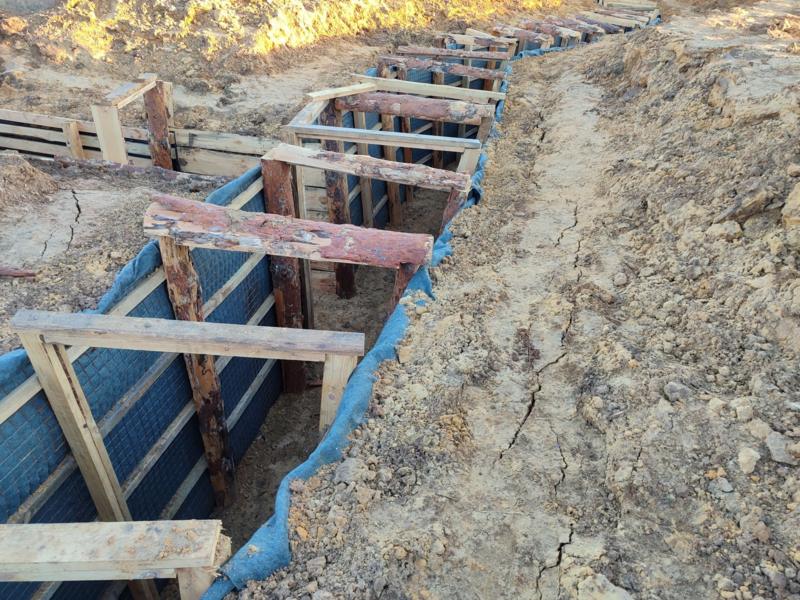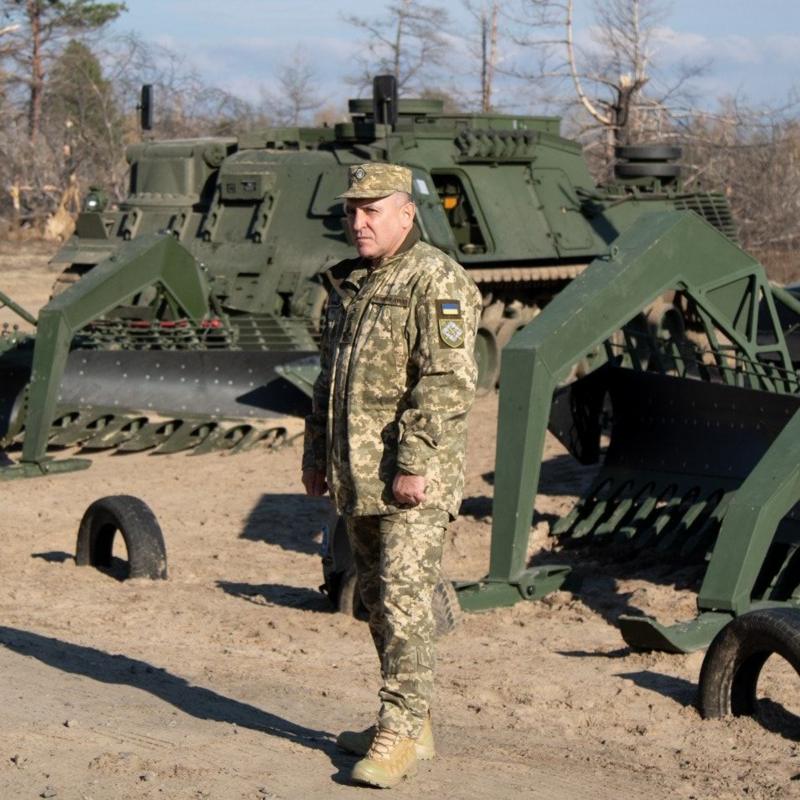С конца прошлого года украинская армия после неудачи наступления перешла к стратегической обороне. Это означает, что на первый план выходит построение масштабных защитных рубежей. Но именно с этим у Киева оказались существенные проблемы.
«Не было ничего, какие-то окопы по колено и все», — военнослужащий ВСУ Николай описывает ВВС Украина, как выглядели инженерно-фортификационные сооружения на второй линии обороны, куда недавно прибыло его подразделение на Востоке.
И такая ситуация не единична. Особенно ярко она проявилась в феврале, когда украинские войска вынуждены были отступать из Авдеевки под давлением россиян. По словам самих бойцов, за городом не оказалось подготовленных рубежей. В частности и это позволило противнику стремительно продвинуться на запад почти на 10 км.
О недостаточности, неподготовленности, а иногда и плохом качестве украинских линий обороны сейчас говорят сами бойцы, военные эксперты, аналитики и даже политики. Парламентская оппозиция требует отчета премьер-министра по «проваленной программе построения фортификаций» и расследования этого.
Глава правительства Денис Шмыгаль в свою очередь заявляет о выделении рекордных 20 млрд гривен с начала года на создание оборонительных рубежей и интенсификацию этих работ.
После огласки информации о плачевном состоянии украинских фортификаций этот процесс существенно ускорился, почти ежедневно военные подразделения и областные администрации начали публиковать фотоотчеты о рытье окопов и построении блиндажей, а координировать этот процесс стал «непубличный куратор» от власти.
Что это за линия обороны?
Для начала следует понять, о каких именно оборонительных сооружениях идет речь. Речь идет о долговременных и полевых военных фортификационных сооружениях, то есть таких, которые возводятся непосредственно у линии боевого соприкосновения и на некотором расстоянии от нее.
Обычно линия обороны состоит из трех основных полос.
Сначала идет «предполье», которое может включать минные заграждения, препятствия из колючей проволоки, противотанковые рвы и бетонные надолбы — «зубы дракона».
Далее начинается главная линия обороны, состоявшая из железобетонных и гранитных ДОТов (долговременных оборонительных точек), ДЗОТов (дерево-земляных оборонительных точек), траншей, землянок, блиндажей и пулеметных гнезд.
За главной линией обороны есть еще одна — резервная, а также артиллерийские позиции.
Классическим примером такого трехуровневого построения является «линия Суровикина», которую россияне возвели на оккупированной части Запорожской и Донецкой областей за полгода — с октября 2022 до весны 2023.
Украина строила свои оборонительные линии еще с 2015 года вдоль линии разграничения на Востоке. Однако они были не настолько мощные и расположены не в тех районах, где сейчас проходят боевые действия.

К примеру, бывший начальник штаба оперативно-тактической группировки «Луганск», а ныне эксперт Центра оборонных стратегий Виктор Кевлюк рассказывает ВВС Украина, что в его зоне ответственности инженерно-фортификационные сооружения возводились вдоль реки Северский Донец на Луганщине.
«Передний край (обороны) проходил по реке, вторая линия обороны была построена параллельно Северскому Донцу и перпендикулярно сегодняшней линии фронта. Поэтому вопрос: какая выгода от этой линии сегодня, если направление ведения боевых действий с востока на запад, а не с юга на север?».
Вдоль государственной границы с РФ на Луганщине вообще не было оборонительных рубежей. По словам Кевлюка, на некоторых участках сделали только ВОПы (взводные опорные пункты), а на других — только сосредоточение резервов в тылу.
Собственно, отсутствие линии обороны на границе и позволило российским войскам в начале вторжения в 2022 году стремительно оккупировать большую часть Луганщины и продвинуться вглубь области.
На других участках фронта, прежде всего на юге Донецкой области, украинские войска вынуждены были отступить от первой линии обороны на вторую под давлением противника, но третью линию обороны не подготовили.
Источник ВВС в командовании инженерных войск также говорит, что оборонительные рубежи, которые возводились с 2015 года, действительно, оказались неактуальными в начале полномасштабной войны, поскольку российская армия фактически обошла их и зашла в тыл ВСУ на многих участках фронта. Фактически последними «старыми» линиями обороны оставались Марьинка и Авдеевка, которые пали в начале этого года под давлением россиян.
Теперь Украина ускоренными темпами пытается возвести новую линию обороны. В первую очередь на наиболее угрожающих участках — возле Запорожья, на западе Донецкой области, а также возле Купянска и вдоль восточной границы с Россией.
Проблемные фортификации
Правда, остается открытым вопрос: почему новую мощную оборонительную линию не начали возводить в первые два года большой войны?
Собеседники ВВС Украина среди причин называются разные версии. В частности, речь может идти о хаосе первых месяцев конфликта, ограниченности финансового ресурса государства и наступательных, а не оборонительных планах украинской власти.
Основную массу работ по возведению оборонительных рубежей вблизи фронта выполняют инженерные войска, которые относятся к Силам поддержки ВСУ. В начале марта президент Владимир Зеленским сменил командующего Сил поддержки. Новым руководителем стал именно начальник инженерных войск Александр Яковец.
По мнению полковника запаса Виктора Кевлюка, сейчас в Украине есть дефицит инженерных подразделений. Это не в последнюю очередь связано с их существенным сокращением в начале 2000-х годов.
Эксперт объясняет: сейчас командующий оперативным командованием на фронте имеет в своем составе полк оперативного обеспечения из трех батальонов, но из них работами по фортификационному обустройству может заниматься только один — тот, который обеспечен необходимым оборудованием и техникой. Это явно недостаточно, говорит Кевлюк.
«Для того, чтобы «закопаться» для проведения оборонительной операции в оперативном командовании нужно иметь примерно 5-8 инженерных батальонов, а есть только 1. Вопрос: почему нет всех остальных? Неизвестно».
До 2014 года Украина сокращала инженерные войска и поэтому сейчас испытывает дефицит подготовленных кадров и техники

Еще одной проблемой является то, что процесс обустройства фортификаций происходил «снизу — вверх», то есть конкретное подразделение отвечало за создание линии обороны только на своем участке и для того, чтобы создать что-то более надежное, чем обычные окопы, должно было постоянно обращаться к высшему командованию за выделением древесины, бетона или техники.
Поэтому на практике возведенные фортификации на каждом отдельном участке существенно отличались друг от друга и не создавали плотного и сплошного оборонительного рубежа. Это давало российским войскам возможность продавливать украинскую оборону на «слабых» участках и заходить во фланг других подразделений.
«Эта проблема есть, но это точно не вина подразделений инженерных войск», — уверяет ВВС один из офицеров, служащий в Командовании сил поддержки ВСУ.
Логика в этом утверждении есть. Объявив о переходе к «стратегической обороне», в декабре 2023 года украинские власти определили, что заказчиками при закупке товаров, работ и услуг оборонного назначения для строительства фортификационных сооружений являются сразу несколько ведомств. Их перечень определен в постановлении Кабмина от 29 декабря.
Среди них Министерство обороны, государственная специальная служба транспорта, местные администрации и государственное агентство восстановления и развития инфраструктуры. Все эти органы должны были бы между собой координироваться при возведении рубежей обороны. Но часто по факту получается наоборот, говорит собеседник из инженерных войск.
Например, местные администрации в некоторых случаях не оказывают необходимой помощи военным, которые вынуждены в условиях отсутствия спецтехники и материалов на скорую руку возводить фортификационные сооружения у линии боевых действий.
Начальник инженерных войск, генерал Александр Яковец в начале марта получил повышение и стал командующим Сил поддержки ВСУ

Член парламентского комитета по вопросам нацбезопасности и обороны Сергей Рахманин (фракция «Голос») говорит, что ВСУ имеют законное право изымать необходимую строительную технику для таких работ, но это должно проходить через местные военные администрации.
«На самом деле, это выглядит несколько иначе — если договорятся с местной властью военные, то она что-то даст, если не договорятся, то не даст. И очень распространенный ответ: «вы все равно это потеряете, разобьете или оно взорвется, и поэтому мы вам этого не предоставим». Таких случаев очень много», — говорит депутат в интервью «Радио НВ».
По его мнению, это проблема связана с низкой «исполнительной дисциплиной» в Украине.
«У нас оказалось, что некому хлопнуть кулаком по столу», — считает Рахманин.
Новый куратор из старой системы
Но кажется, что украинская власть таки нашла того, кто будет «стучать кулаком». Достаточно неожиданно им оказался бывший заместитель главы Офиса президента Украины Кирилл Тимошенко. С 1 марта он является штатным советником министра обороны Рустема Умерова.
Три источника, в частности из ОП и Минобороны, подтвердили ВВС Украина, что на своей должности он занимается в том числе и темой возведения фортификаций.
Министерство в ответ на запрос ВВС ответило, что «основное направление» работы Тимошенко — это медиа и коммуникации, координация информационной политики в Министерстве обороны и подчиненных структурах, а также построение «единой информационной повестки» в Силах обороны.
Вопрос о причастности нового советника к масштабной компании по возведению оборонительных укреплений в ведомстве проигнорировали.
Так же и Кирилл Тимошенко во время общения с ВВС отказался подтвердить или отрицать свою причастность к фортификационной тематике. Он заявил, что, действительно, присутствует на многих совещаниях Минобороны по различным вопросам, но основная его функция — быть советником министра по коммуникационной политике.
«Слава Богу, что это делается», — так прокомментировал он вопрос масштабной государственной программы по возведению оборонных рубежей, отказавшись более детально объяснить свою роль в этой работе.

Кто же такой Кирилл Тимошенко? За непродолжительное время пребывания в украинской политике он заработал себе неоднозначную репутацию.
В команду Зеленского он попал еще во время президентской кампании 2019 года. В то время 30-летний медийщик занимался производством рекламных и предвыборных роликов, телевизионных программ и был владельцем рекламного агентства.
С мая 2019 до января 2023 года Тимошенко занимал должность заместителя главы Офиса президента, где отвечал за региональную и медийную политику.
До российского вторжения в 2022 он также курировал стратегическую программу власти «Большая стройка», на которую тратили огромные суммы денег. Поэтому под критику относительно их расходов попадал и сам Тимошенко.
Из-за коррупционных нарушений при реализации этой масштабной и дорогостоящей программы правоохранительные органы открыли ряд уголовных производств. У некоторых фигурантов, в частности у экс-главы Днепропетровской областной госадминистрации Валентина Резниченко, были проведены обыски.
Однако к Тимошенко у правоохранителей по «Большому строительству» не возникло вопросов. Но позже он получил обвинения от Национального агентства по вопросам предотвращения коррупции по другому делу.
По мнению НАПК, в 2022 году представитель ОП незаконно использовал ценный автомобиль Porsche Taycan, который ему якобы предоставил знакомый в «безвозмездное пользование». Кроме того, НАПК инкриминировало Тимошенко то, что он трижды в течение 2022 года «бесплатно проживал» в гостиничном комплексе «Emily Resort» во Львовской области, а также помог выехать своему подчиненному за границу якобы для служебной командировки. Настоящей целью выезда якобы был частный интерес — оформление виз Тимошенко и его сыну.
Однако осенью прошлого года суд отклонил все аргументы НАПК и признал Тимошенко невиновным.
Что касается возведения линий обороны, то в Министерстве обороны сообщили ВВС, что действительно ведут мониторинг строительства фортификационных сооружений. Этим занимается координационный штаб, в состав которого включении представители министерства и ВСУ.
«Штаб постоянно осуществляет взаимодействие с привлеченными к выполнению мероприятий заказчиками строительства и областными военными администрациями, в зоне ответственности которых осуществляется строительство», — говорится в ответе на запрос.
Оборонительные работы ведутся на всех направлениях, во всех определенных 14 областях. Процент готовности фортификационных сооружений в ведомстве раскрыть отказались, но отметили, что сроки строительства установлены как «максимально возможно сжатые».
По оперативным данным, по состоянию на 5 марта из выделенных средств уже использовали около 2 млрд гривен. Но Минобороны отмечает, что выделенное финансирование (речь идет о 20 млрд гривен) не покрывает общей потребности для полного выполнения строительных работ.


